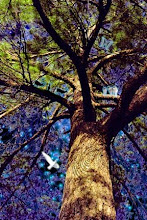

Basket weaving techniques
Four basic weaving techniques are used to construct baskets: wicker, plaiting, twining, and coiling. Wicker, plaiting, and twining all interlace wefts (horizontal elements) and warps (vertical elements), but each technique brings to basketry subtleties of design, color, and form. Coiling is more like sewing. Each of the basic weaves has numerous variations, and weavers sometimes use several variations on a technique in a single basket, or combine two or more techniques. Ultimately, the beauty of a basket’s weave reveals the weaver’s creative vision and technical adeptness at both preparing her materials and manipulating them into a basket form.
Plaiting
In plaiting, or checkerwork, two elements are woven over and under each other at right angles. Twilled weave is much the same, except that the weft (horizontal) materials are woven over two or more warps (verticals). In the Southwest, winnowing baskets, known as yucca-ring baskets, are often plaited. Southeastern basket-makers have made twill-plaited cane basketry for thousands of years. Checker- and wicker-plaiting predominate in the Northeast, where 19th-century basket-makers also used curled weft overlays to begin the “fancy basket” tradition that continues among today’s weavers.
Wicker
In wicker, the basket-maker weaves the weft material over and under a stiff foundation or warp of rods or bundles of fiber. In the American Southwest, wicker is used to make serving baskets and trays. Hundreds of wicker plaques are made each year at Hopi to be used in katsina and basket dances and give-aways. Wicker is found less frequently in other parts of North America.
Twining
Twined work begins with a foundation of rigid elements, or warp rods—very often whole plant shoots—around which two, and sometimes three or four, weft elements are woven. The wefts are separated, brought around a stationary warp rod, brought together again, and twisted. The action is repeated again and again, building the basket. Subtle and elegant patterns are made by changing the number of wefts (as in braiding and overlay), or the number of warps the wefts pass over (as in diagonal weaves). A weaver may use any number of twining variations in a single basket. False embroidery, a technique in which a decorative element is wrapped around the wefts, on the outside face of the weave, is often seen on plain twining.
Coiling
Coiling begins at the center of a basket and grows upon itself in spiral rounds, each attached to the round before. Weaving coiled baskets is a sewing technique, as the basket-maker uses an awl to punch holes in the foundation through which she draws sewing strands. These strands are single pieces of plant fiber that have been trimmed to a uniform size. The foundation is made up of one, two, three, or sometimes more slender plant shoots, bundles of grass or shredded plant fibers, or a combination of grass and sticks. In coiling, designs are not made by changing the weave, but rather by using a different color sewing thread. Imbrication, a decorative technique unique to coiled baskets made by Salishan peoples of the Pacific Northwest, involves folding a strip of grass, bark, or other fiber under each sewing stitch on the outer surface of the basket.





No comments:
Post a Comment